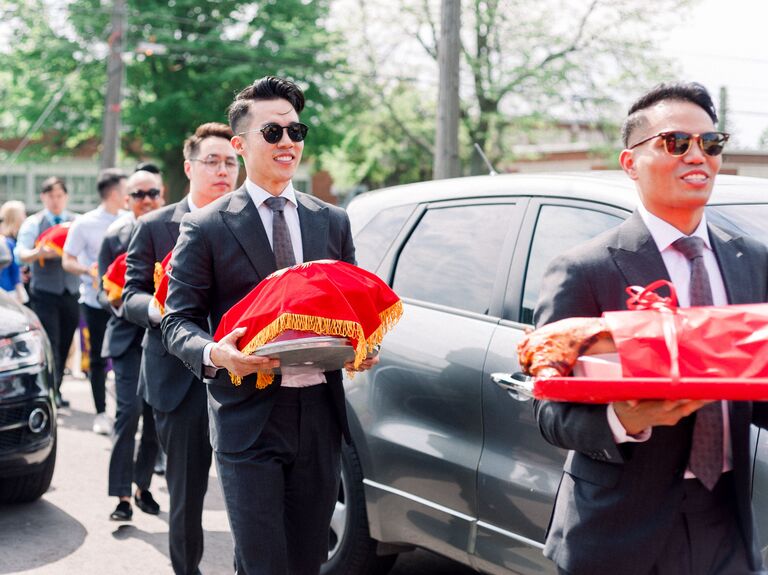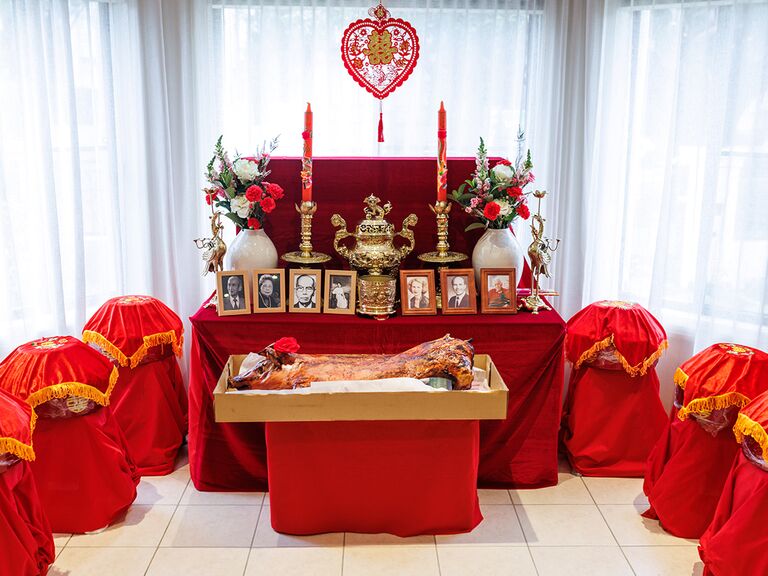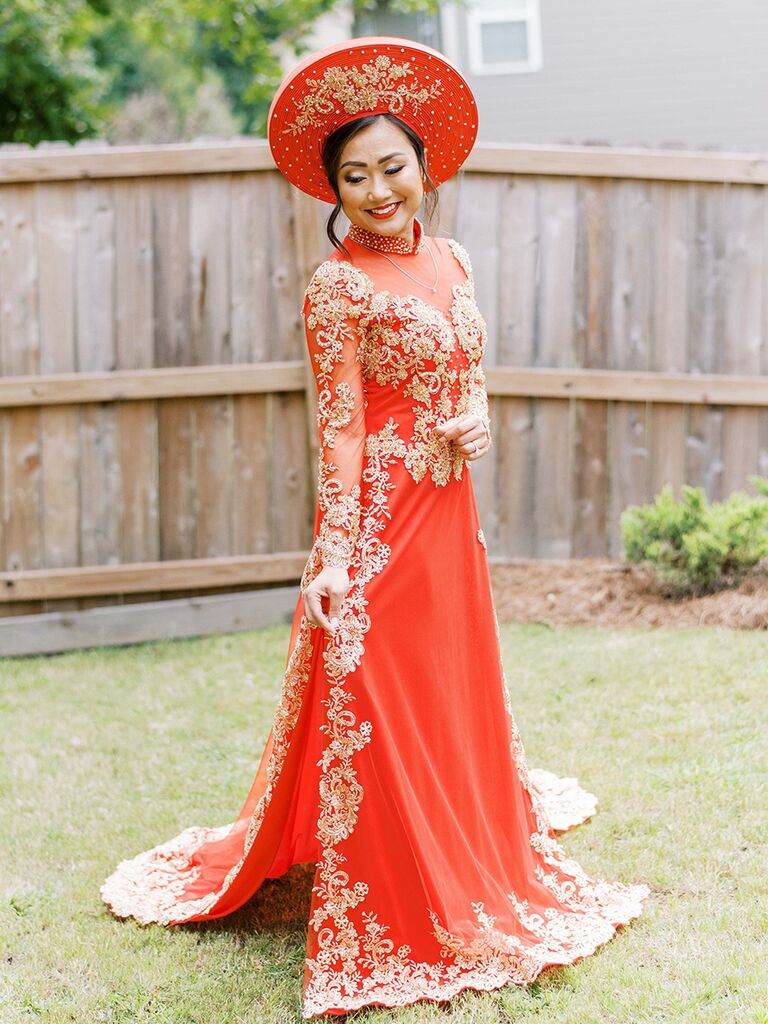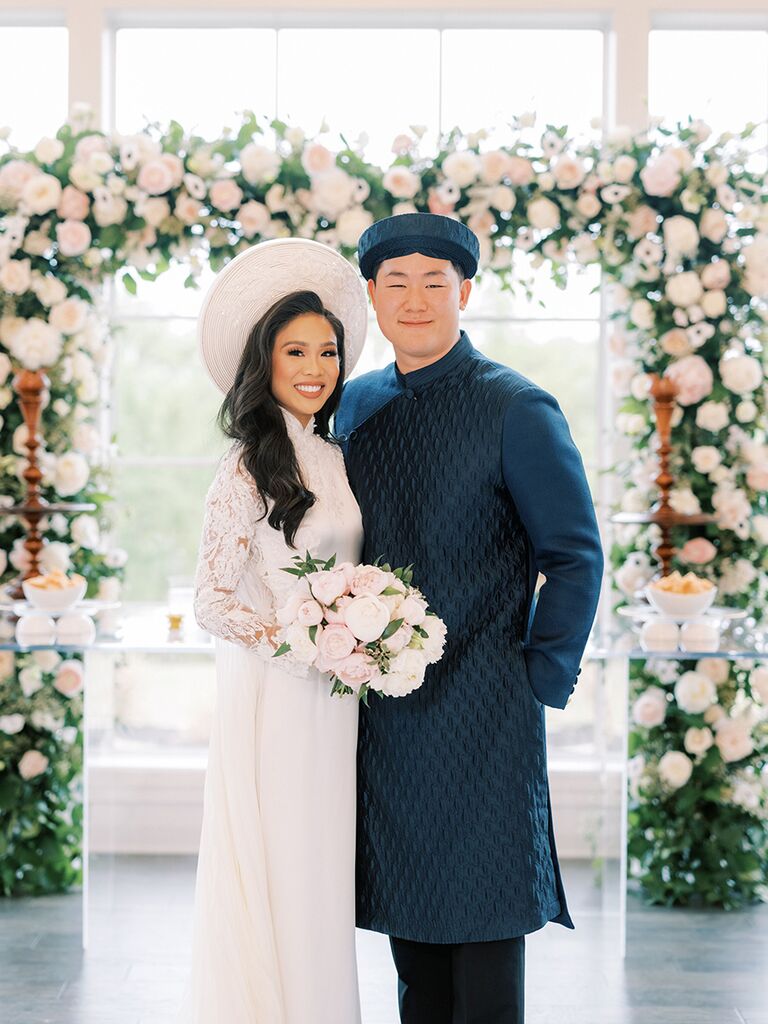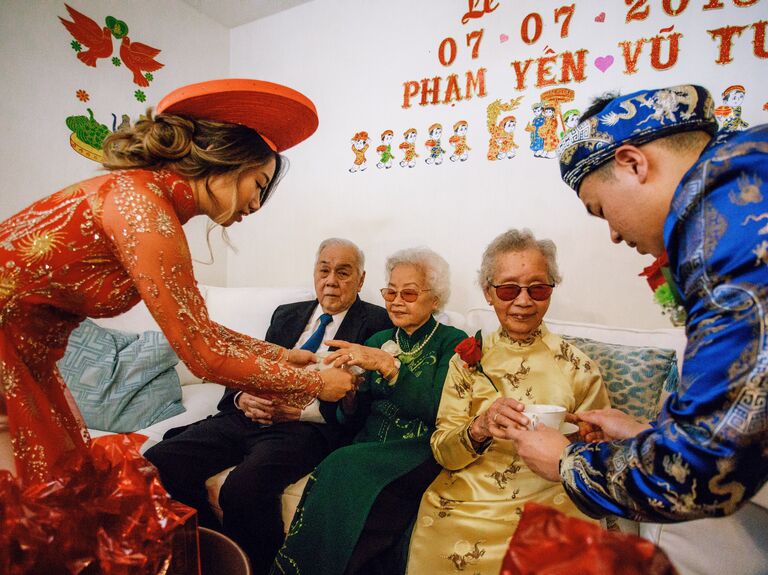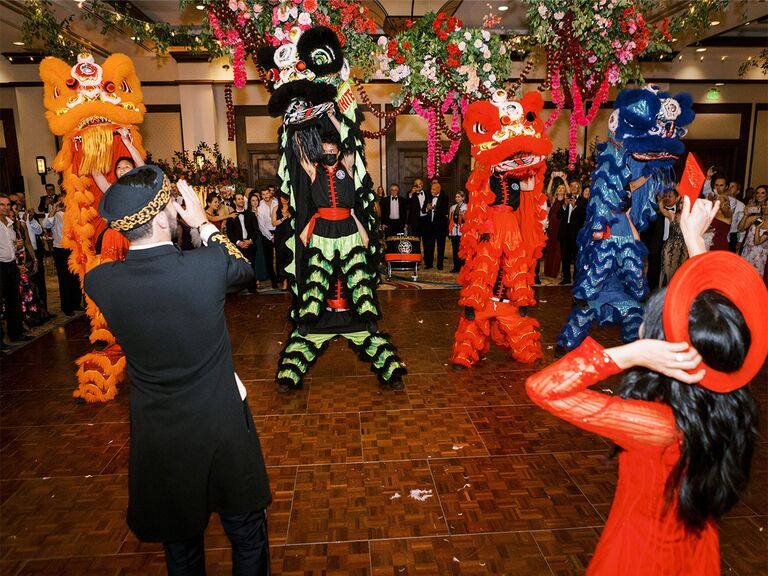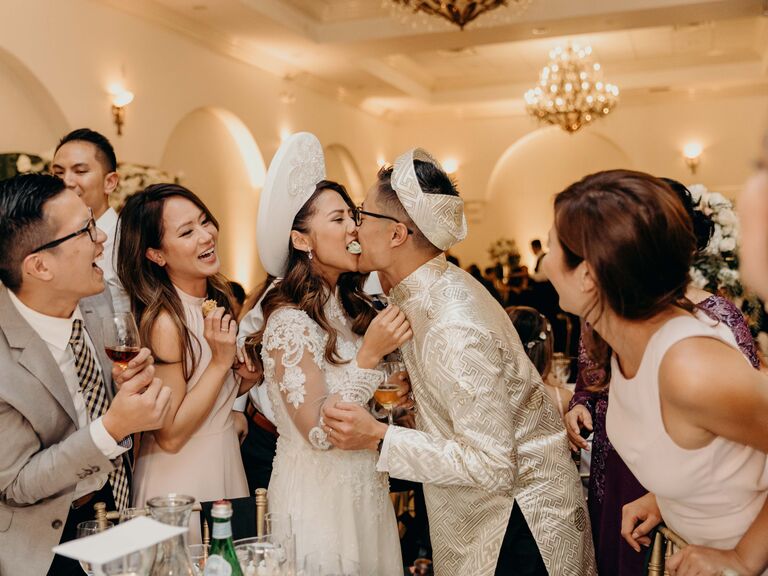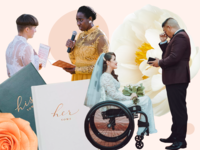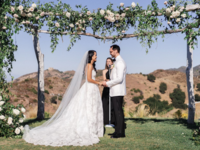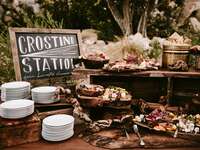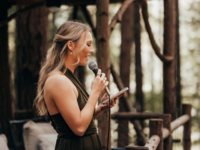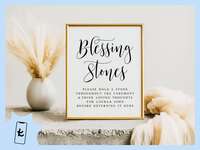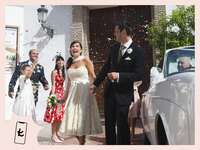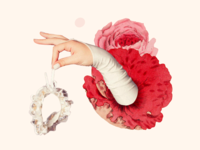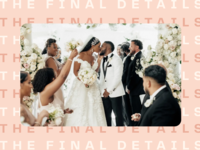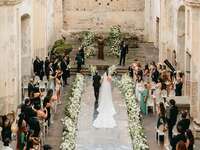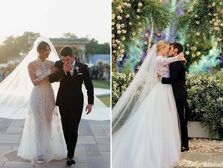19 Significant Vietnamese Wedding Traditions to Incorporate into Your Celebration
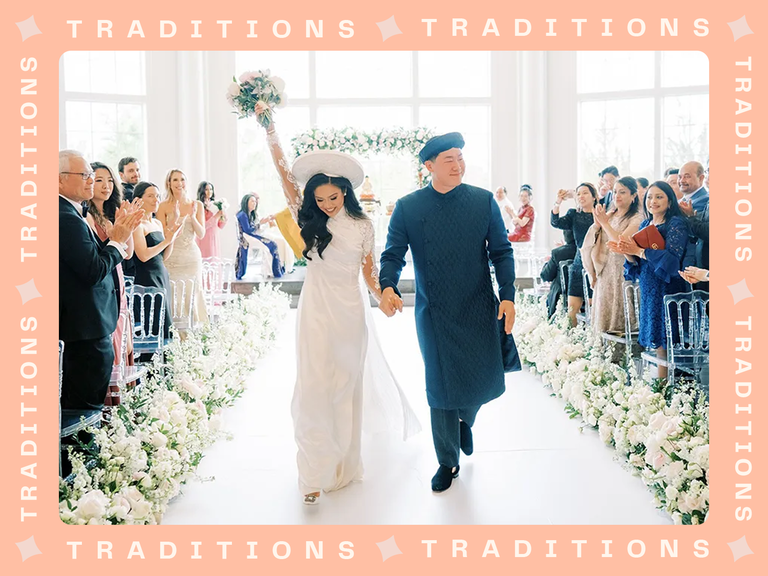
Whether you want to add some Vietnamese wedding traditions into your multicultural celebration or are having a Vietnamese wedding, it's crucial that you properly honor your heritage. From customary colors and fashion choices to rituals showing appreciation for one's elders, we're taking a look at the Vietnamese marriage customs you can expect to see. But, like many wedding traditions from across the world, it's ideal to have someone who's immersed in the culture to lead you down the right path during the planning process. That's why we tapped a few pros to offer their expert insight. Here are your Vietnamese weddings guides: Lizzy Liz Chan, owner of Lizzy Liz Events with 20 years of wedding planning experience, Tuan Bui, founder of Tuan B & Co. who's been taking photos since he was eight years old and Phuong Nguyen, floral designer and CEO of Mibellarosa since its creation in 2011.
Once you've studied up on the traditional Vietnamese wedding customs below, start reaching out to pros who can bring the practices to life. Head to The Knot Vendor Marketplace where you and your partner can find vendors, using the Asian-owned businesses filter, to help with all the logistics.
Vietnamese wedding traditions in this story: History | Prewedding | Attire | Ceremony | Reception | Food & Drink | Gifts
A Brief History of Vietnamese Wedding Traditions
In Vietnamese culture, family is a large part of every wedding. Typically, families even help plan the big affair and the prewedding events. This foundational aspect of Vietnamese wedding culture isn't unusual since it's believed that the marriage isn't just between the to-be-weds, but also between the two sides of the family who are joining as one. We also want to note that many of the following rituals describe the union of a bride and groom, but LGBTQAI+ couples can celebrate pretty much the same way. LGBTQAI+ couples might have to modify some of the traditions though. Historically, Vietnamese weddings, which translates to "đám cưới" in Vietnamese, have been heterosexual don't be afraid to make the customs your own.
Prewedding Vietnamese Traditions
The ceremony and reception aren't the only events where couples can appreciate their heritage. Check out these customs that occur before the love birds say, "I do."
Dạm Ngõ (Preproposal Family Discussion)
Nguyen also explains that historically there's an additional pre-engagement step, the Dạm Ngõ, that takes place. "The Dạm Ngõ (also known as the Đám Nói) is when the parents of the bride and groom come together to discuss the pending engagement of the couple after the couple expresses their intent for marriage. This is the first official engagement for the families."
Auspicious Wedding Dates
Selecting a wedding date is one of the first steps in planning a wedding. For Vietnamese weddings, it is especially important for couples to choose a wedding date that is meaningful and auspicious. Chan explains that "parents typically take the couple to a temple to find an auspicious date and time. Factors such as birthday, time, Chinese zodiac sign and element," all weigh into the decision making process for selecting an ideal favorable wedding date. (Fun fact: This is one of the many traditions across Asian cultures that some couples practice.)
Luxe Engagement Photos
"Most Vietnamese couples take engagement photos in their wedding attire," says Chan. While in many Western weddings it's commonplace to have a first look where to-be-weds see each other in their wedding attire for the first time, that's less common with Vietnamese weddings. "It's typical that the groom has seen the bride in her wedding dress prior to their wedding day and goes shopping with her," says Chan of traditional Vietnamese engagement photos.
Nguyen also explains that historically there's an additional pre-engagement step, the Dạm Ngõ, that takes place. "Prior to the Vietnamese Đám Hỏi is the Dạm Ngõ (also known as the Đám Nói), during which the parents of the bride and groom come together to discuss the pending engagement of the couple after the couple expresses their intent for marriage. This is the first true official engagement for the families."
The Đám Hỏi (Engagement Party)
Historically, a formal Vietnamese engagement ceremony, known as đám hỏi, is the first step in the engagement and wedding planning journey. "The đám hỏi is the process of the groom and groom's side asking the bride's family for her hand in marriage. It's also an introduction of the family members of both sides and a way to honor family and ancestors," explains Chan.
Nguyen adds, "Typically, during this marriage proposal tradition, the groom and his family arrive at the bride's family home to present gifts and dowry and speak to a representative of the bride's family before they grant permission to the groom and hand off their daughter for marriage. Finally, the bride's family will bring out the bride to join the couple together." After the official proposal ends, the families have lunch to celebrate and emphasize the significance of two families joining in a beautiful union.
During the Vietnamese đám hỏi, Chan advises that "the groom's side lines up with offerings of food and alcohol. Then, the groom's family fills up mam qua, which are red tins that are filled with gifts. You will find bottles of the most expensive Cognac, sticky rice, luxury teas, desserts, fruits and items that symbolize prosperity, wealth and luck. A roasted pig is also part of the offering." Next, a playful game commences with the bride's family guarding the door to see what the groom has to offer the bride's family. Sometimes Vietnamese red envelope wedding proposals, filled with cash, are offered before presenting the mam qua red tins. There are even times when the bride's family challenges the groom to show that he has the strength to take care of his future wife, which involves making him do push-ups, jumping jacks and other activities.
Once the bride's family accepts the gifts and the groom passes these challenges, the groom's side is welcomed into the home. Next, the bride's parents escort the bride to see her partner, which is a cue for the groom to present a bouquet to the bride and both sides to introduce themselves then go into a welcome speech and prayer. "Family members are assigned to light candles and incense to honor their ancestors and serve tea to their parents, grandparents and elders. The groom's parents shower the bride in jewelry and more red envelopes. After the parents and grandparents are served tea, the family lines up to receive a tea offering from the couple and to give the couple red envelopes and jewelry. Traditionally, to make it official, the groom escorts the bride back to his house, followed by the bride's family. They all meet at the groom's house for a secondary tea ceremony and followed by lunch hosted by the groom," explains Chan.
In regard to the structure, the đám hỏi is almost an exact mirror of the wedding ceremony. "It involves the same procession, reception, gift-giving, speechifying and presentation of the bride and the same tea ceremony. Doing a traditional đám hỏi isn't common these days, but back in antiquity, the đám hỏi was sometimes the event where the groom met the bride for the first time,"Bui tells us. Now, for modern Vietnamese wedding events, the ceremony is amended to be like a traditional Western-style engagement party, which means more casual and with fewer customs.
Traditional Vietnamese Wedding Attire
What the to-be-weds and guests wear has meaning attached to it too. Below are five traditional Vietnamese wedding clothes and accessories you can expect to see at the celebration.
Áo Dài
An áo dài is a traditional Vietnamese wedding dress "worn by the bride and the groom—the bride wears a red one and the groom wears a blue one," says Bui. Chan explains that couples typically get their áo dài custom-made and may fill the design with meaningful references. "For example, if the groom was born in the year of the dragon, the bride may incorporate fabric with a dragon design into her attire," Chan adds. The color choices for áo dài are also especially important. "The combination of red and gold or all-white is reserved only for the couple on the wedding day," says Nguyen.
Áo Dài Cưới
"Even with all the customs and tradition, Vietnamese brides are still able to bring their own twist to their weddings. Brides typically have three outfit changes throughout the day. The enhanced bridal version of an áo dài is called a áo dài cưới, which means it has been modernized with long trains or capes," Nguyen explains.
Áo Gấm
The áo gấm is a groom's version of a leveled-up áo dài. Áo gấm is different because of the thicker fabric and more ornate designs on the tunic.
Khăn Ðóng
"There's a traditional Vietnamese hat, called a khăn đóng, that's made from concentric strips of fabric. Usually, the women's version of this is much larger than the men's, and is asymmetrical, with the front being much more sloped than the back. Whereas the men's is much smaller and is even all around. These are for the bride and groom to wear, and are matched to the color of their áo dài," Bui says.


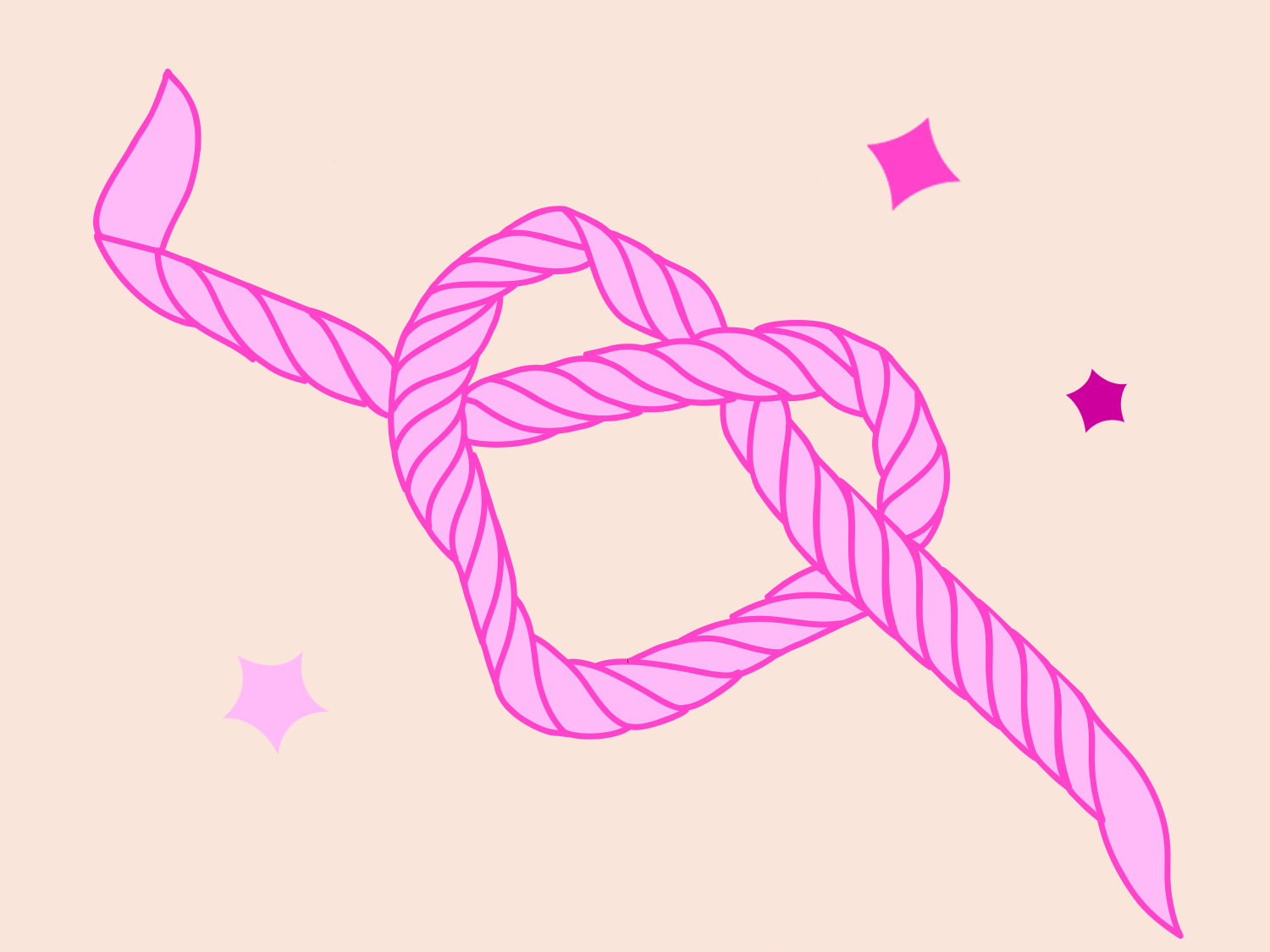
Vietnamese Guest Attire
As for guests, it's important to keep in mind what colors not to wear to a Vietnamese wedding. "Wedding guests shouldn't wear black because it's associated with funerals. Besides that, don't do purple florals since they represent sadness and no white florals because they are connected to death and funerals," advises Chan. Additionally, she encourages wedding guests attending Vietnamese wedding celebrations to "always wear something formal, do not wear jeans, khakis or casual attire to a Vietnamese wedding. If you come looking casual or sloppy, it's disrespectful to the couple. If you're a guest, you can rent an áo dài! It would surely impress the to-be-weds." Nguyen says that guests are encouraged to wear brightly-colored clothes to signify happiness for the couple.
Vietnamese Wedding Ceremony Traditions
Whether you're doing multicultural wedding planning or focusing solely on your Vietnamese heritage, you need to decide on your ceremony timeline. Learn what traditions you can incorporate into your wedding today.
Lễ Rước Dâu (Wedding Processional)
Lots of different cultures' ceremony and reception entrances involve family, like this Vietnamese wedding custom. Important to note that a traditional Vietnamese wedding looks very similar to the đám hỏi. Bui explains that a Vietnamese wedding day starts with the groom's family and friends forming a procession line, traditionally at the groom's house, and parading to the bride's house. "This is remarkably impractical most of the time, so usually the groom's side forms a procession a little bit down the block from the bride's house," says Bui. This procession is the groom's close family and friends, and is headed by a couple, like the groom's parents or an elderly couple of the group. The groom himself will be at the end of the procession, often carrying a bouquet. Bui adds, "Each person in line, save for the head couple and groom, will carry fabric-covered trays bearing gifts, usually involving components of a feast; fruit, candy, moon cakes (bánh trung thu), pandan rice cakes with mung bean (bánh xu xê), other pandan rice cakes with mung bean (bánh cốm), colorful mounds of sticky rice (xôi), wine and if you're lucky, a whole roast suckling pig (heo quay)."
Next, the groom's procession parades up to the door of the bride's house, where an equivalent couple from the bride's family greets them. The groom's designated head couple will ask for permission to enter, and the bride's head couple will grant it and the whole parade will go inside the bride's house, to be met by the bride's family. (The bride herself is hidden in a different room.) The bride's family is then tasked with accepting the gifts, taking the trays and someone from the bride's side (usually the bride's dad) will give a speech welcoming the groom's family. After that, the bride is escorted into the room to applause, and the groom presents the bride with her bouquet.
Prayer at the Altar and Asking for Blessings
At this point in the wedding day, it's time for the couple to pray at the altar and ask for wedding blessings. Bui explains that "first the groom's parents, then the bride's parents, then the bride and groom pray together. Vietnamese tradition doesn't neatly fall into any of the world's major religions, so the prayers are directed to the couple's ancestors." The altar typically has lit candles and small offerings of food and sometimes incense that the penitents will clasp in their hands until their silent prayers are done. Then, they place the stick of incense in a small censer. At the end, the couple may exchange jewelry, placing wedding rings on each other's fingers, and if there was a gift of jewelry in the procession earlier, this is ceremoniously put on the bride. There are also monetary gifts given to the couple in small envelopes, called lì xì.
Lễ Vu Quy (Vietnamese Wedding Tea Ceremony)
It's customary to include a Vietnamese tea ceremony and candle ritual to the day's festivities, this tradition is called vu quy, meaning "tea ceremony" in Vietnamese. This is the moment when the couple presents tea to their parents and grandparents. When the elders drink the tea, it symbolizes them accepting the couple's marriage, which is followed by them offering advice for a long-lasting, healthy marriage. Incense is then offered to the ancestors as a way to introduce the groom to the bride's family ancestors. Lastly, the union is bonded by candle lighting, which is when the couple lights a dragon and phoenix candle, and the bride's family offers gifts to the couple. The thành hôn, the official wedding ceremony when the couple gets married, follows the traditional Vietnamese tea ceremony and takes place at the groom's home. Chan elaborates by explaining that some modern couples forgo tea in favor of alcohol—one of the differing Vietnamese wedding traditions in America. "Each family is different, so the teapot can be filled with tea or alcohol. So be careful!"
Honoring Elders
Over the course of a Vietnamese wedding day, the couple will honor their elders and ancestors in a variety of meaningful ways. Nguyen elaborates, "Vietnamese couples honor their elders by involving them in each step of the wedding process leading up to the reception. The traditions set in place value each parent's opinion and pay respect to the deceased ancestors. In addition, the procession of gifts to the bride's family (or the mâm quả), is another way to pay respect to the bride's family and thank them for raising the bride to the individual she is today." Some couples bow to their parents to honor them, which shows gratitude and respect towards their parents for raising them to be who they are and thanking them for their constant love and sacrifice.
No Officiant for the Ceremony
Some people may be surprised to learn that there isn't a specific moment in Vietnamese ceremonies where an officiant pronounces the couple married. Compared to a Western-style ceremony, there isn't an officiant in charge of the proceedings, so each side of the family needs to know the ceremony order. "Furthermore, what I've seen with less traditional Vietnamese weddings in America is that often the exchange of rings doesn't happen during the ceremony at all. Instead, the Vietnamese portion of the wedding happens at the beginning of the day and then a more modern American ceremony takes place in the afternoon or evening with a processional, officiant, exchange of vows and rings and recessional," Bui says.
Vietnamese Wedding Reception Traditions
There are not many reception traditions since the majority of the Vietnamese customs are at the beginning of the day. The reception is usually the most westernized part of the wedding, with the grand entrance, first dance, toasts and cake-cutting ceremony.
Lion Dancers
Many Vietnamese wedding receptions showcase lion dancers. Chan explains that a lion dancer performance "is to bless the couple for a long and happy marriage." This reception addition serves as great cultural entertainment for you and your guests.
Chào Bàn (Reception Greetings)
During dinner service, the newlyweds greet each table to thank them for coming in a custom called chào bàn, which translates to "hello, friend." While tables with elders are simply met with words of wisdom and cheers, tables with younger guests typically play short drinking games with the couple.
Traditional Vietnamese Wedding Food and Drinks
Food is a big part of Vietnamese wedding celebrations as is alcohol. Below is what you can expect at just about any Vietnamese wedding.
Cognac
Cognac is a highly-favored spirit at Vietnamese weddings, which means you'll need to order a lot of it. Historians believe that since Vietnam was a former French colony that that's the reason why the appreciation for Cognac is so strong among the Vietnamese community. Nguyen says a bottle of Cognac is a staple part of the tablescape for Vietnamese weddings, "so the guests can immediately get the party started without having to hit the bar."
A Large Feast
Food at Vietnamese wedding receptions is usually served family-style and may have a minimum of eight courses. Some of the wedding food traditions for Vietnamese weddings include: fried fish, Peking duck, seafood soup, honey walnut shrimp, cold seafood platters, fried rice and much more.
Vietnamese Wedding Gifts
"Vietnamese wedding guests are usually expected to give the cost of their meal in envelopes," explains Nguyen. "When the couple is invited to the guests' wedding in the future, they are expected to do the same in return. This alleviates financial stress on the newlywed couple, who typically pay for the wedding themselves, and allows for a more lively atmosphere with higher attendance." It's important to note, if you're going to be a guest, that couples don't have wedding registries and that one of the Vietnamese wedding traditions is gifts being in monetary form. After eating, the newlyweds go to each table to greet their guests and also collect envelopes of wedding money.

